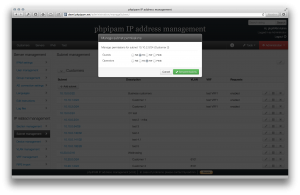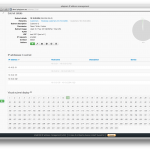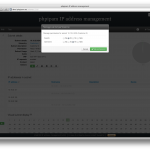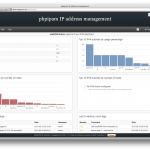Packet Design to Challenge Engineers at Cisco Live
Company Will Launch its "Do You Know Everything?" Campaign on the World of Solutions Exhibit Floor
Packet Design, the leading provider of IP network route analytics software, announced a new marketing campaign today at the 2013 Cisco Live Conference in Orlando, Florida.
Packet Design will introduce some levity to the serious world of IP networking by challenging visitors to its booth on their Knetwork Knowledge℠. Packet Design routing experts will test attendees on their expertise in IGP and BGP routing protocols, MPLS WANs, Layer 2 and 3 VPNs and RSVP-TE tunnels. Attendees will leave not only with a higher level of Knetwork Knowledge but also a tee shirt that gives them bragging rights. In addition, they will understand how Packet Design’s Explorer™ family of products:
- Gives real-time visibility into Layer 3 topology and routing for proactive service delivery management
- Allows replay of the topology and all routing events at any point in time for forensic analysis of network issues
- Enables interactive modeling to understand the impact on routing and traffic flows of planned network changes, new workloads and component failures.
“IP networking is complex and sometimes the people responsible for ensuring the availability and performance of critical networks Continue reading
Bufferbloat in switches/bridges
I received the following question today from Ralph Droms. I include an edited version of my response to Ralph.
On Thu, Jun 20, 2013 at 9:45 AM, Ralph Droms (rdroms) <rdroms@yyy.zzz> wrote:
Someone suggested to me that bufferbloat might even be worse in switches/bridges than in routers. True fact? If so, can you point me at any published supporting data? Thanks, Ralph
It is hard to quantify as to whether switches or routers are “worse”, and I’ve never tried, nor seen any published systematic data. I
 wouldn’t believe such data if I saw it, anyway. What matters is whether you have unmanaged buffers before a bottleneck link.
wouldn’t believe such data if I saw it, anyway. What matters is whether you have unmanaged buffers before a bottleneck link.
I don’t have first hand information (to just point you at particular product specs; I tend not to try to find out whom is particularly guilty as it can only get me in hot water if I compare particular vendors). I’ve generally dug into the technology to understand how/why buffering is present to understand what I’ve seen.
You can go look at specs of switches yourself and figure out switches have problems from first principles.
Feel free to write a paper!
Here’s what I do know.
Ethernet Switches:
- The simplest switch Continue reading
Vendor PSA: Words and Phrases to Avoid in Presentations
Over the years IT professionals have sat through countless presentations, conference calls, and keynotes. We’ve been preached too, explained “the problem”, and forced to bear witness to the the future. During such events all of us have had to step up and explain that we already understand the problem, we know who your company is, and we really just want to know how your product works.
Outside of the normal annoyances, there are several words or phrases that invoke pain and disgust in our hearts, one such phrase came up today. While I won’t mention the source, or berate them anymore than they already have been. I do want to put this list out there for future reference… If I’ve forgotten something that drives you crazy, please, feel free to contact me so I can add it here.
- Cloud — we’ve jumped the shark with Cloud years ago….
- Gartner — No one that understands technology cares what Garner says. Period.
- Magic Quadrant — See above.
- Single Pane of Glass — An overly obvious marking term.
- Next Generation — Really? Prove it.
- Game Changer — See above.
- Software Defined $something — Just like Cloud, we’ve driven this into the ground
- And Continue reading
Know Your Competition: Observations From Structure
I spent the day yesterday at GigaOM’s Structure conference in San Francisco trying to see what my colleagues around the technology world are up to these days. If you have haven’t been to Structure, it’s always a good event – well organized, lots of 20-minute discussions and plenty of networking opportunities. There were definitely interesting nuggets shared from a variety of speakers at the show.
For example, I loved it when Ben Haines, formerly of Pabst Brewing, said he worked for “The Department of No.” I’m probably going to “borrow” that because it’s the reason Embrane is trying to help IT, and particularly the networking team. As I wrote in a recent blog post, Don't Hate the Players Hate the Tools, IT and the networking team need to have the tools at their disposal so they have to stop saying no to requests that require immediate action because they can’t react fast enough.
Then there was the CIO from Clorox, Ralph Loura, who said he’s constantly trying to make IT agile. As he said, his goal is to help IT enable business productivity. He gets it! He knows that if he doesn’t, the business units will go off Continue reading
CCIE R&S v5 blueprint announcement?
How does the internet work - We know what is networking
UPDATE on 2.11.2013 – There will be an update in February 2014! Read all about the new announcement in the latest article here! with all new topics added and removed from CCIE lab exam v5. UPDATE on 23.07.2013 – There will be not update this year to v5 at least not for now… […]
Host Interfaces on UCS FEX 2204 vs FEX 2208
I mentioned in a previous post regarding the connectivity options to each blade if you’re using the appropriate hardware. If you’re using a 2208 FEX, you have 8 upstream ports, each at 10GbE. This means the FEX can support up to 80 Gbps total. You can provide potentially 4:1 oversubscription (math later) to each blade by connecting a 2208 FEX into a blade chassis with blades that can also support 80Gbps each.Host Interfaces on UCS FEX 2204 vs FEX 2208
I mentioned in a previous post regarding the connectivity options to each blade if you’re using the appropriate hardware. If you’re using a 2208 FEX, you have 8 upstream ports, each at 10GbE. This means the FEX can support up to 80 Gbps total. You can provide potentially 4:1 oversubscription (math later) to each blade by connecting a 2208 FEX into a blade chassis with blades that can also support 80Gbps each.phpIPAM version 0.8 released
Dear all, I am happy to announce new version of phpipam IP address management – version 0.8. Quite some bugs have been squashed and some new features introduced, like per-group permissions, support for translations, visual subnet displays and other: 
- New group and permission management;
- Support for translations;
- Subnet resizing;
- Subnet splitting into smaller subnets;
- Added free space display for nested subnets;
- Added visual display of subnet usage per IP address;
- Added truncate network option that deletes all IP addresses in subnet;
- Added button the updates subnet with RIPE information;
You can demo it here: http://demo.phpipam.net/
You can download it on sourceforge site: phpipam-0.8.
Please note that IE8 is no longer supported!
Special thanks to all the people submitting bug reports, donors, translators and feature testers!
Screenshots:





Full changelog for this release is:
New features:
----------------------------
+ New group and permission management;
+ Support for translations;
+ Subnet resizing;
+ Subnet splitting into smaller subnets;
+ Added free space display for nested subnets;
+ Added visual display of subnet usage per IP address;
+ Added truncate network option that deletes all IP addresses in subnet;
+ Added button the updates subnet with RIPE information;
Enhancements:
----------------------------
+ Continue reading
On accents, colloquialisms and proprietary extensions
I may not be the most “travelled” person in the world, but over the past couple of years I have managed to find myself in several places across Asia, the Pacific Islands and also the US. One thing has always stood out – Speaking the same language is the hardest part of travelling! Now when I travel to parts of Asia and Im dealing either in hand gestures or with somebody trying their very best speak English (Their English is 1000x better than my Cantonese or my Khmer), and we both make allowances for the difficulty of not speaking the same language.
Sadly, when I travel to the United States and we both attempt to speak “English” nobody can ever seem to understand me. Sometimes its my accent, and other times its the colloquialisms I am using that do not translate effectively, and I am treated by blank stares on the other person trying their hardest not to say “Huh?”.
I’ve learned to deal with this by talking slower and thinking carefully about the words I use to ensure that they dont have some local significance. Anybody who has met me in person knows that I talk loudly, quickly Continue reading
CCIE Lab Exam attempt #2 – How I’m going to study better!
Well it has been just over 7 weeks now since I failed my first attempt at the CCIE Lab Exam in Routing & Switching in Brussels. On the way home on the Eurostar I had vowed to take the weekend off and get straight back on the horse and start labbing again for 4 hours […]
Author information
The post CCIE Lab Exam attempt #2 – How I’m going to study better! appeared first on Packet Pushers Podcast and was written by Roger Perkin.
5 Reasons to Consider Working For a Technology Reseller
For the first several years of my career, I worked for a smaller technology reseller. These types of organizations are often known as value added resellers, or VARs. The role of a VAR is to combine their expertise with some technology they sell in a way that solves the challenges of their customers. The expertise […]
Author information
The post 5 Reasons to Consider Working For a Technology Reseller appeared first on Packet Pushers Podcast and was written by Paul Stewart.
NX-OS vPC FEX configuration example
ip add 1.1.1.2/29
ip route 0.0.0.0/0 1.1.1.1
desc vPC Peer-Link members
channel-group 1 mode active
desc vPC Peer-Link
vpc peer-link
switchport mode trunk
sw trunk allowed vlan list
spanning-tree port type network
peer-switch
role priority 4096
system priority 4096
peer-keepalive destination 1.1.1.3 source 1.1.1.2 vrf management
pinning max-links 1
desc "FEX 101"
channel-group 100
channel-group 101
switchport mode fex-fabric
fex associate 100
vpc 100
switchport mode fex-fabric
fex associate 101
vpc 101
ip add 1.1.1.3/29
Cisco UCS Port-Channeling
Cisco UCS offers a few policies that are applied globally to all equipment in a given UCS domain. These policies are found by selecting the “Equipment” node under the “equipment” tab. (You can also change on an individual chassis basis but the default behavior is for all chassis to inherit this global policy) This is specifically referring to the connectivity between the Fabric Interconnects and the Chassis FEX modules or I/O modules (IOM).Powerless Words and Technology
I was introduced by a colleague and mentor a few years ago to the concept of powerless words. Words like “try”, “but”, and “maybe/might”, among others, seem to be our mind’s way of protecting itself against the unknown. After all, we’re only human, right? We can’t control what the world throws at us, right? I encourage you to read the article I linked to as well as this one, which the first article refers to.Cisco UCS Port-Channeling
Cisco UCS offers a few policies that are applied globally to all equipment in a given UCS domain. These policies are found by selecting the “Equipment” node under the “equipment” tab. (You can also change on an individual chassis basis but the default behavior is for all chassis to inherit this global policy) This is specifically referring to the connectivity between the Fabric Interconnects and the Chassis FEX modules or I/O modules (IOM).Powerless Words and Technology
I was introduced by a colleague and mentor a few years ago to the concept of powerless words. Words like “try”, “but”, and “maybe/might”, among others, seem to be our mind’s way of protecting itself against the unknown. After all, we’re only human, right? We can’t control what the world throws at us, right? I encourage you to read the article I linked to as well as this one, which the first article refers to.RFC 3330 Filtering Using Network Objects
RFC3330 Special-User IPv4 AddressesBelow is a list of special use IPv4 address assigned by IANA and should be blocked inbound on external connections. Most security administrators block RFC1918 but do not realize that RFC3330 includes special use addresses that should not be traversing the internet. RFC3330 includes addresses referenced in multiple RFC's including RFC1918.
Address Block Present Use
--------------------------------------------------
0.0.0.0/8 "This" Network
10.0.0.0/8 Private-Use Networks
14.0.0.0/8 Public-Data Networks
24.0.0.0/8 Cable Television Networks
39.0.0.0/8 Reserved but subject to allocation
127.0.0.0/8 Loopback
Continue reading
